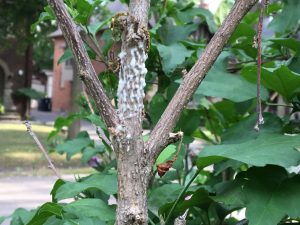
Follow up to my question: “Every year a couple of branches die in my Rose of Sharon. The rest of theshrub look happy and flowers. The sick branch wilts and dies and does not come back. Any answers?”
Thank you for answering this question. I review the leaves and did not find any spots, insects or holes. But I found this! It looks like fungus to me. Would this solve the mystery? Thank you for your time and your care.
Thank you for writing back and sending us additional photos.
From your photo it appears that your Rose of Sharon has an infestation of woolly aphids. Woolly aphids get their name form the fluffy, wax-like substance that covers their bodies. At first glance you may mistake this for fuzzy mold. These sap-sucking pests generally use two hosts: one for overwintering and laying eggs in spring, and one for feeding in summer. Woolly aphid insects generally feed in groups. They can be seen feeding on foliage, buds, twigs and branches, bark, and even the roots. Damage may be recognized by twisted and curled leaves, yellowing foliage, poor plant growth and branch dieback,which is what you are currently observing. Aphids exude a sticky substance called honeydew. If left untreated, plants may become covered with sooty mold, an unsightly black fungus that resembles soot. Though this does not normally affect or damage the plant itself, getting rid of the aphids and their honeydew will help control the sooty mold.
The best solution to ridding your tree of these pests is your garden hose set on full blast. Spraying them will knock them to the ground and they will be unable to return to the host. Do this every few days until you no longer see any signs of them. Where aphid infestation is abundant you can use insecticidal soap, which is available at your local garden center. Make sure to follow directions on the label.
The following website gives additional information on how to control these pests.
Tips for Woolly Aphid Treatment,
Hope this information helps.

